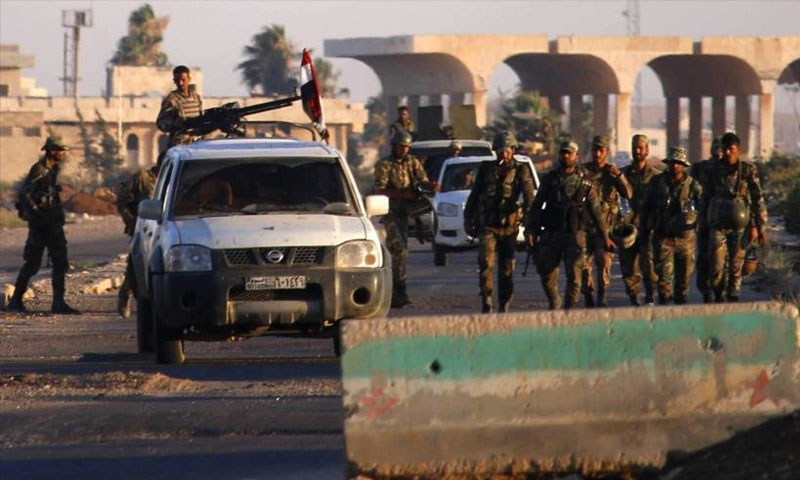



Enab Baladi – Daraa
There has been a race between groups of the Syrian regime forces to take control of the Nassib border crossing with Jordan, in search for a financial source to cover expenses of the “settlement” groups, which the Military Security branch and the “Fourth Division” are their biggest recruiters.
The “Fourth Division,” led by Maher al-Assad and supported by the Lebanese “Hezbollah” militia, installed physical barriers on the Jordanian side of the border crossing, which diminishes Military Security control, and limits it to the incoming traffic only, as monitored by Enab Baladi‘s correspondent and other sources in Daraa.
The crossing is currently closed from both sides, Syrian and Jordanian, over coronavirus (COVID-19) outbreak, as a precautionary measure in both countries.
Signs of disagreement emerged between the “Fourth Division” and the Military Security branch after the former brought reinforcements and clashed with the former leader of the “Yarmouk Army,” Imad Abu Zureik, who owns a breakout area inside the crossing and benefits from selling contraband and smuggled smoke.
Abu Zureik has a vast influence at the crossing due to his direct relationship with the Military Security branch, led by Brigadier Louay al-Ali, who persuaded him and gave him influence being a resident in the Nassib region and a former leader in the opposition. Abu Zureik was able to recruit a bunch of people for the benefit of the Military Security branch from Nassib residents, according to local testimonies monitored by Enab Baladi.
A media activist from the Eastern region (who preferred to remain anonymous due to security concerns) told Enab Baladi that the crossing was under the control of the Military Security branch before the arrival of the “Fourth Division,” which seeks a financial profit to cover its expenses.
Similarly, a former leader in “Jaysh al-Thawra” ( the Army of the Revolution) (who asked to remain anonymous) confirmed to Enab Baladi that all these disputes and attempts are basically to establish control to obtain financial returns, as the “Fourth Division” is looking for financial sources to pay salaries of the “settlement members.”
According to media activist Basel al-Ghazzawi, both the Military Security branch and the “Fourth Division” seek to obtain financial returns by illegal means, through smuggling operations taking place inside the crossing.
These smuggling operations are not limited to weapons and drugs, as they include smoke, meat, and unpermitted items that may not be transported between the two countries under the laws governing commercial exchange.
However, al-Ghazzawi does not think that the “Fourth Division” and the Military Security branch are conflicting rivals, he believes that the real dispute lies between the “Fourth Division” and the settlement fighters from Nassib town, in Daraa countryside, who benefit from the crossing, while being affiliated to “Military Security” branch.
From al-Ghazzawi perspective, the “Fourth Division” will resolve the matter with the reopening of the crossing; it will also share the revenues of smuggling operations because the crossing is located in the area of factions associated with the Military Security branch, which may create a create a continuous instability for the “Fourth Division.”
After a three-year closure, precisely since the Syrian opposition factions took control of it in 2015, regime forces reopened the Nassib-Jaber border crossing in October 2019, after taking full control of the Daraa and al-Qunaytirah provinces.
The regime expected a trade growth with the reopening of the crossing and a significant improvement in Syrian Pound against other foreign currencies, but this step did not reflect positively on the Syrian economy.
The economy in Syria witnessed a deflation in 2019, along with a sharp decline in the value of the Syrian Pound by crossing the 1000 pound barrier against the dollar.
The minister of finance in the Syrian Interim Government (SIG), Dr. Abdel-Hakim al-Masri, told Enab Baladi that the regime’s control of the crossing is formalistic and unrealistic and that the aim of reopening the crossing is to facilitate Lebanese Hezbollah’s attempts to smuggle narcotic drugs.
According to al-Masri, being the “largest drug trafficker and promoter,” “Hezbollah” attempts to transport and smuggle drugs to Jordan, the Arab Gulf, and Egypt, referring to the quantities of confiscated drugs at the crossing since its reopening, which belongs to “Hezbollah.”
In addition to smuggling operations, being a source of livelihood for the regime forces, or the “settlement” factions near the Nassib crossing, passengers are forced to pay bribes to move between the two countries.
Uday Jaber, a Jordanian young man, told Enab Baladi about the way he was treated during his last visit to Syria and described how the crossing is being exploited by those who control it.
Uday, 26-years-old young man, arrived to Damascus through Jordanian borders, after eight hours on the road, and the same amount of time on his way back, due to the Syrian regime’s army, “mistreatment at checkpoints, “which forced him to pay a bribe.
Uday estimated bribes paid on behalf of the passengers on his bus, by 100 Jordanian Dinar (JOD) (approximately 72,000 SYP) (56 USD), paid on eight different checkpoints, in addition to interrogating the passengers.
Nassib crossing revenues reached 9.8 billion SYP (7.626.459 USD) at the end of 2019, while the freight transport movement decreased at the beginning of this year compared with last year.
According to a report published by “al-Watan,” a pro-government newspaper, stated that the freight transport movement decreased to ten trucks daily, after it was 50 trucks at an average rate at the end of 2019.
Meanwhile, the Ministry of Transport published a report in which it stated that the number of cars driving through the Nassib crossing in the past year reached 413.138 cars of various types, including 322.000 entering Syria.
The total number of Syrian returnees, who used to live in camps and entered Syria through the Nassib crossing, is estimated by 28 000 returnees.
if you think the article contain wrong information or you have additional details Send Correction